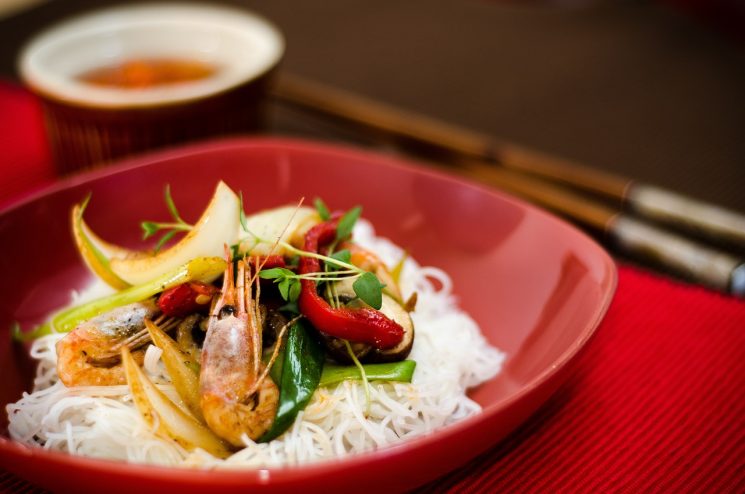
By Stephanie Nguyen
Disclaimer: If you’re considering modifying your diet you should first consult a medical professional.
It’s no surprise East Asia’s obesity rates are low compared to the rest of the world (obesity is defined as a BMI of 30+ as defined by the CDC). Japan has an obesity rate of around 5%, South Korea at around 7%, China at around 14%, and Taiwan at around 8%. East Asian diets typically consist of a variety of vegetables, nutritious carbs, and comforting soups and teas that make up a balanced meal. Portions are small but filling. Recently, many East Asians have joined social media to share health advice including exercise routines, as well as going to the gym a lot more than in the past. They are becoming a bigger part of the health and fitness community — not just at home — but in America as well.
One of the most popular videos shared within the fitness community on social media are “What I eat in a day” videos. They’re videos of influencers sharing what a day of eating looks like for them. When East Asians posted such videos; however, there was criticism of the portion size and alleged lack of nutrients. Some users claimed those videos were promoting eating disorders, alleging the calorie total isn’t enough and the meals have too many carbs and too little protein. Neither criticism is helpful to anyone interested in improving their health.
There are a couple of reasons why such comments can misinform people. There isn’t a specific number of calories everyone should be eating. Some sources recommend ranges as broad as 1600-3000 calories. And even people whose caloric needs fall below or above that range don’t have to adjust their diet to fit within that range, because it’s a guideline, not a rule. Not everyone burns 1600 calories just by sitting around (this is called the Resting Metabolic Rate), and in order to lower the number on the scale, more calories have to be burned than eaten.
This means that someone would have to exercise and eat less at the same time in order to burn more calories than their resting metabolic rate. If someone burns 1600 calories without exercise, they’ll have to burn more than 1600 to lose weight and not maintain it. Therefore, any number of calories suggests starting points, but it’s okay if that starting point isn’t the most effective for someone. As long as the person has a healthy body and mind, the number of calories they’re eating doesn’t matter.
The importance of a balanced diet is why criticizing a diet for “lacking” in protein is unhelpful at best. Protein has become a coveted macro in America, and there are a lot of videos sharing recipes having a lot of protein. However, not everyone needs the same amount of protein, just like how not everyone needs the same number of calories. Excess protein can get stored as either fat or carbohydrates, causing weight gain, and it is associated with a higher risk of heart disease and cancer when the protein source, such as red meat, has a higher saturated fat content.

A balanced East Asian diet won’t cause either of those issues, yet it has enough protein because vegetables, tofu, soy, etc. have amino acids, which are linked together into protein. Meat isn’t the only source of amino acids, and to claim a diet lacking red meat, chicken or protein powder/shakes to be lacking in nutrients is to potentially dissuade people from making decisions that could help them.
There are a few reasons why East Asians eat less meat compared to Americans. Buddhism is a prominent religion in the region, with 14% of Chinese and South Koreans, 46% of Japanese, and 28% of Taiwanese identifying as Buddhist. In Buddhism, veganism is encouraged, so devout Buddhists go vegan for days at a time for religious holidays. Sometimes they’re vegan for most of their lives. Meat is also expensive for many people, while vegetables are easier to buy and prepare.
It’s true white rice is a staple of East Asian cuisine. In places like America that have a lot of refined and sugary grains, people are often told to avoid carbohydrates. However, they are essential. Carbohydrates are a source of energy, break down calories, and help the liver detox the body. So grains like white rice are okay. White rice is often enriched with nutrients like folate and vitamin B, but even if it isn’t, it doesn’t lead to weight gain if eaten in smaller portions each meal, like in East Asian diets. Anything can be eaten if it’s in moderation.
Despite criticizing East Asian diets, Americans like to keep things balanced too. The criticism wasn’t made because they can’t comprehend eating healthy. Sometimes non-Americans unfairly stereotype Americans as being fat, inactive patriots who never saw a vegetable outside of Taco Bell.
On the contrary, Americans are more conscious about their habits than ever, with about half of Americans surveyed indicating they’re interested in eating better. Balanced American plates are usually loaded, with vegetables, healthy fats, whole grains, and of course, protein. Meals tend to be higher in calories, but for some people, this is fine, especially if they go to the gym or follow intense workouts. To judge someone’s plate for being big is no better than judging it for being too small.
It can be easy to assume all Americans are pigs, yet healthy, hearty meals might be what’s best for them. Should anyone be called a pig for eating what makes them healthier? Being healthy means eating what is best for your own body, not for someone else’s. What’s best for somebody is anything that improves their overall health, including but not limited to reducing their risk for diseases, and a lower body fat percentage.
No matter what part of the globe you’re from, we all have similar goals to manage our weight. For some, this means more food or protein, and for others, it means less. Neither one is more “correct” or “wrong” than the other.
As the American health community continues to grow, it should be more accepting of different diets and ideas flowing in to allow for more diversity, which helps everyone. As people often say, “don’t yuck my yum!”





